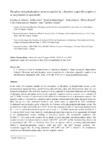Mostrar o rexistro simple do ítem
Phosphate and polyphosphate anion recognition by a dinuclear copper(ii) complex of an unsymmetrical squaramide
| dc.contributor.author | Esteves, Catarina V. | |
| dc.contributor.author | Costa, Judite | |
| dc.contributor.author | Esteban-Gómez, David | |
| dc.contributor.author | Lamosa, Pedro | |
| dc.contributor.author | Bernard, Hélène | |
| dc.contributor.author | Platas-Iglesias, Carlos | |
| dc.contributor.author | Tripier, Raphaël | |
| dc.contributor.author | Delgado, Rita | |
| dc.date.accessioned | 2022-03-18T09:40:14Z | |
| dc.date.available | 2022-03-18T09:40:14Z | |
| dc.date.issued | 2019-05-29 | |
| dc.identifier.citation | C. V. Esteves, J. Costa, D. Esteban-Gómez, P. Lamosa, H. Bernard, C. Platas-Iglesias, R. Tripier and R. Delgado, Phosphate and polyphosphate anion recognition by a dinuclear copper(II) complex of an unsymmetrical squaramide, Dalt. Trans., 2019, 48, 10104–10115. DOI: 10.1039/C9DT01434A. | es_ES |
| dc.identifier.issn | 1477-9234 | |
| dc.identifier.uri | http://hdl.handle.net/2183/30056 | |
| dc.description.abstract | [Abstract] In the search for receptors suitable for the recognition of phosphate or polyphosphate anions, a new unsymmetrical squaramide-based ligand bearing dipicolylamine (dpa) and ethylpiperazine units (L) was designed and prepared. The acid–base reactions of L, its copper(II) complexation behaviour and the binding of phosphate and polyphosphate anions by the copper(II) complexes used as receptors were evaluated. 1H and 13C NMR titrations of L performed in D2O allowed the determination of its protonation sequence. The ligand L is able to coordinate two copper(II) cations forming thermodynamically stable dinuclear complexes likely having two water molecules bound to each metal centre, as supported by DFT calculations. Coordinated water molecules can be replaced by the O-donors of the phosphate/polyphosphate anions. The potentiometric studies showed that at 2 : 1 Cu2+ : L ratio the dinuclear [Cu2LH−1]3+ species predominates from pH ∼ 5 to ∼7, and hydroxodinuclear species prevail at pH > 7. 1H NMR experiments in both H2O/D2O 9 : 1 v/v and in DMSO proved that copper(II) coordination provokes deprotonation of the squaramide NH bound to the ethylpiperazine moiety, resulting in [Cu2LH−1]3+ species. The dicopper(II) complexes of L, [Cu2LH−i]4−i, were used as the receptor for the uptake of some phosphate and polyphosphate anions. The receptor presents very high association constants with HPPi3− and ATP4− and the determined Keff showed that at physiological pH ATP4− is selectively taken from an aqueous solution containing phenylphosphate (PhPO42−), aminoethylphosphate (Haep−), AMP2– and ADP3−, but HPPi3− strongly interferes. DFT calculations suggest that the strong interaction with HPPi3− and ATP4− is related to the simultaneous coordination of the polyphosphate unit to the two copper(II) centres. | es_ES |
| dc.description.sponsorship | This work was partially supported by Project LISBOA-01-0145-FEDER-007660 (Microbiologia Molecular, Estrutural e Celular) funded by FEDER funds through COMPETE2020 – Programa Operacional Competitividade e Internacionalização (POCI) and by national funds through FCT. The NMR data were acquired at CERMAX, ITQB-NOVA, Oeiras, Portugal with equipment funded by FCT, project AAC 01/SAICT/2016. C. V. Esteves thanks FCT for the PhD fellowship SFRH/BD/89501/2012 and Project LISBOA-01-0145-FEDER-007660 for a last fellowship | es_ES |
| dc.description.sponsorship | Portugal. Fundação para a Ciência e a Tecnologia; LISBOA-01-0145-FEDER-007660 | es_ES |
| dc.description.sponsorship | Portugal. Fundação para a Ciência e a Tecnologia; AAC 01/SAICT/2016 | es_ES |
| dc.description.sponsorship | Portugal. Fundação para a Ciência e a Tecnologia; SFRH/BD/89501/2012 | es_ES |
| dc.language.iso | eng | es_ES |
| dc.publisher | Royal Society of Chemistry | es_ES |
| dc.relation.uri | https://doi.org/10.1039/C9DT01434A | es_ES |
| dc.title | Phosphate and polyphosphate anion recognition by a dinuclear copper(ii) complex of an unsymmetrical squaramide | es_ES |
| dc.type | info:eu-repo/semantics/article | es_ES |
| dc.rights.access | info:eu-repo/semantics/openAccess | es_ES |
| UDC.journalTitle | Dalton Transactions | es_ES |
| UDC.volume | 48 | es_ES |
| UDC.issue | 27 | es_ES |
| UDC.startPage | 10104 | es_ES |
| UDC.endPage | 10115 | es_ES |
Ficheiros no ítem
-
GI-REACT! - Artigos [107]






